February 22nd, 2008 — art, design
On Tuesday, I attended the press preview and opening night events for Design and the Elastic Mind at the MoMA in NYC. It opens to the public Sunday, February 24th and includes works from designers, scientists, digital artists and thinkers from across a wide range of disciplines; my projects Twittervision and Flickrvision are featured.
I strongly recommend that you check out this exhibition, especially if you’re interested in the intersection between science, design, and art. There are some stunningly beautiful and provocative pieces. While the core ideas behind many of the pieces are technical — computation, informatics, bioscience — good design is required to make the information presentable and understandable to a broader audience. Paola Antonelli, curator for Architecture and Design at the MoMA, has done a remarkable job of assembling these pieces.
Here are some photos from the party Tuesday night.
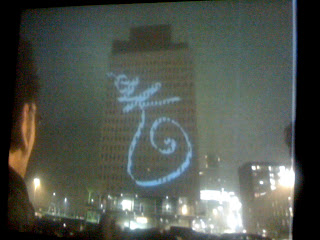

Large scale, open-source Graffiti Projection System from Graffiti Research Lab. I need to build one of these. The graffiti is “painted” where the green laser hits. Note that the paint drips “up” in this photo. You can do that with digital paint!
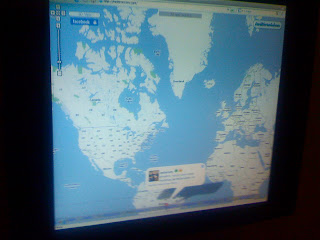
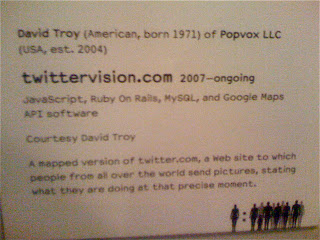
This still seems improbable.
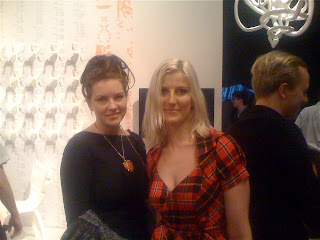
Sofia Lagerkvist (right) w/partner from Front Design. Creators of the remarkable “Sketch Furniture”, which can be drawn freehand in 3-space, then rendered in plastic using a laser-based process. Insane. Create your own furniture that looks like it’s straight out of a cartoon!
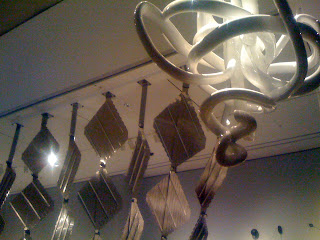
This is an example of an object created with the Sketch Furniture process.

The Painstation video game; where the punishment for losing is actual pain, inflicted by a table-mounted wristband!
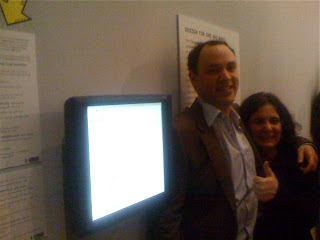
Adam Putter and Janis Mussat. Their project Beerfinder.ca helps beer drinkers in Toronto coordinate beer runs, navigating complex store-closing hours!
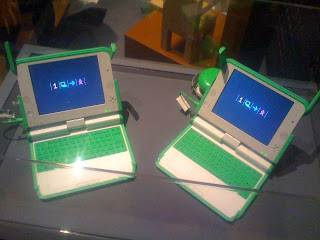
No contemporary design exhibit is complete without the OLPC!

Me and Paola Antonelli, MoMA Curator of Design & Architecture.
She curated Design and the Elastic Mind.
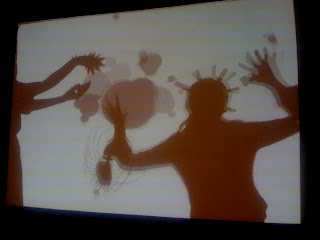
My favorite installation in the show, Shadow Monsters by Philip Worthington. Transforms people into amazing sights and sounds. You need to see this.
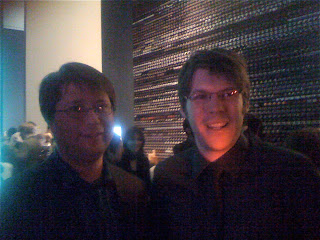
Me and Ian Spiro of fastfoodmaps.com, a Google maps project that shows the fast-food restaurants in the United States. He wishes he had more time to devote to this. He thinks Arby’s is retreating, but he wants to prove it!
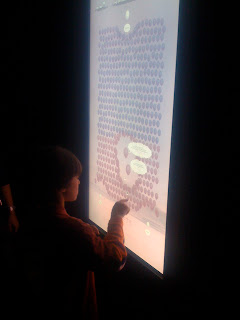
“I Want You to Want Me” is a project by Jonathan Harris and Sep Kamvar, of wefeelfine.org fame. This project scrapes data from online dating sites and attempts to make sense of it. It uses a giant touch screen and is visually quite impressive.
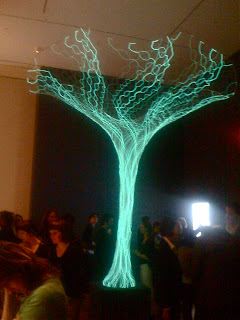
A giant, pulsating 15′ tall “tree” made from what appear to be clear-coated fiberoptic strands. Really, really impressive piece of work. It is the “Sonumbra” by Rachel Wingfield and Mathias Gmachl.
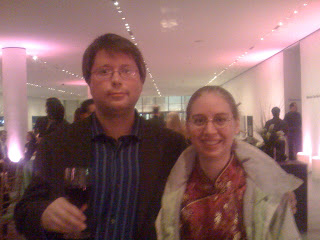
Me and Noelle Steber of the Google Moon project. Noelle was responsible for assembling the Apollo data and is a student at MIT.
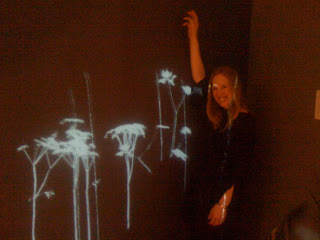
My wife Jennifer, showing off the digitally projected “Lightweeds” by Simon Heijdens.
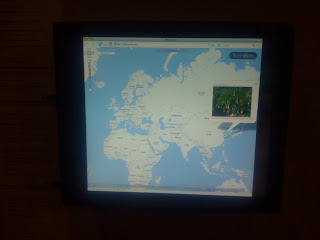
My other project, Flickrvision
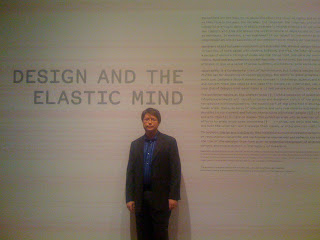
All in all, a successful evening. Design and the Elastic Mind will run through May 12, 2008! I hope you get a chance to see this exhibit in person!
February 18th, 2008 — programming, software, trends
Today I want to rant about a few things I hate. They include:
- The Word “Mashup”
- Proclamations of the form: “A Thing is Dead; Long Live that Thing”
- People Who Insist on Continuing to Use the Word Mashup
- The Term “Web 2.0”
I know it’s heresy. Mashups and Web 2.0 are what’s hot, right? I myself am considered to be a “mashup creator” working with Web 2.0 concepts.
But that era is behind us. The term “Mashup” made sense when coders were actually lifting data from places it was hard to lift from and putting it into contexts that were hard to access. This, my friends, is no longer the state of affairs on the Internet.
Today, we are working with a world of data that wants to be free and is published via countless, well documented API’s. In the cases where API’s are still not available (or whorishly published in hopes of becoming universally adopted), advanced tools and protocols are available to automate what used to be hard.
We must remember that the word “mashup” hails back to music, originally; a talented music editor might string together pieces of previously recorded music to create something new. This was an artform in itself, and implied a kind of subversion. A repurposing of content, often done without the permission or knowledge of the original creator.
Well, the days of this kind of thing on the Internet are, thanks to everybody’s efforts to open things up, largely over. In a world where open source software is widely accepted, where it makes sense for companies like Facebook, Google, Yahoo, Twitter, Amazon (and gee, every other damn company out there) to publish API’s that encourage their data to be woven into the fabric of the net, there is no need for the coy sense of subversion that comes from the word “Mashup.”
What we’ve got now, folks, is DATA! Great flowing rivers of it! Software that helps us use it! Ruby on Rails, Asterisk, MySQL, PGSQL, Apache, Freeswitch, Flex! Where it’s not open source, it’s at least free! Everything has an API and the things that don’t are falling away.
The next person that says to me with a straight face that they “make mashups” is going to get sucker-punched. The word has lost its meaning, so let’s move on.
That said, explaining to a layperson what it is we “creative coders” do, sometimes you, well, have to resort to saying, “I make mashups.” But do us all a favor, try to explain what that really means today. Let’s move to a world where we can think about data, about tools (which is really just code-as-data), and imagining what we can do with it all.
Mashup was a good word for perhaps 2003-2007, but it implies limitations and barriers that simply no longer exist. We can do better.
What would YOU call the innovations that are possible with all the data and tools we have today?
February 17th, 2008 — design
Well folks, it’s shaping up to be a busy few weeks!
This week, my projects Twittervision and Flickrvision will be opening at the Museum of Modern Art in New York, in an exhibit called Design and the Elastic Mind. A press preview will be held on Tuesday morning at 10AM, and opening night will be at 6:30 or something that day. It’s pretty exciting; I never suspected my locking myself in a room and coding would lead to this sort of thing! The exhibit is open to the general public Feb 24-May 12, 2008.
UPDATE:
Opening Night Photo Report!
Beyond that, here’s what else is going on:
Jeff Pulver’s Social Media Breakfast in New York – Feb 26 8AM
Jeff’s been sponsoring these events in cities across the country (and around the world) the last few months, and I made it to the most recent one in Washington DC on February 7th. It was a blast; a chance to catch up with some old friends and make many new ones. If you are interested in social media, I suggest you seek out one of these breakfasts near you. Seek out the details for this event on Facebook and RSVP. They fill up fast.
If all goes well, I will also be appearing on Jeff’s show PulverTV as part of my visit to New York that day. Please stay tuned for the details on that.
eComm 2008 – Sunnyvale, CA – March 12-14
I’ll be speaking at eComm 2008 about open source telephony, social media and making wild and crazy things. eComm is the next version of what was O’Reilly Media’s eTel show. While no longer affiliated with O’Reilly, it should be the premier venue for telecommunications innovators and will feature a good representation from the handset, carrier, and open-source worlds. Of all the shows I attended last year, eTel was one of the most valuable, and eComm is carrying the torch forward.
There’s still time to get in on eComm. Please visit the eComm website for more information and to register.
VON.x 2008 Spring – San Jose, CA – March 17-20
This is Jeff Pulver’s big semi-annual US tradeshow about IP Communications. While originally focused on VoIP, it has expanded to cover video and social media. I’ve been attending nearly every VON show since 2003 or so and have found the sense of community and camaraderie to be very valuable. Don’t miss the party. Jeff manages to get some great bands and everybody always has a great time.
This year VON.x will be co-located with Digium Asterisk World, a joint-venture between Pulver Media and Digium. I’ll be speaking at Digium Asterisk World on March 18th. Please visit the VON website for more information and to attend.
Other Jeff Pulver Social Media Breakfasts
I’ll also be attending these other Jeff Pulver social media breakfasts:
- San Jose, March 17 (as part of VON)
- Baltimore, March 25 (it’s in my hometown!)
- Washington, DC, May 1
I’m looking forward to meeting folks at all of these events and hope to have a lot to talk about in the next few weeks. Meantime, please do stop by the MoMA in New York and check out Design and the Elastic Mind.
See you on the road!
January 28th, 2008 — visualization
Well, folks, it’s here. The new global time-waster video art project, Spinvision.TV!

Since releasing Twittervision and Flickrvision last year, I’ve been imagining what other kinds of visualizations could be created. It was really a natural progression. First text, then photos, and now videos. It’s a trilogy of global media trivia.
Spinvision.TV takes videos from YouTube and plots them on a moving globe. The globe is provided by my friends at Poly9 and is built in Flash; since Flash includes video player capabilities, it was a matter of tweaking things to get the Poly9 FreeEarth component to work the way I wanted it to, and Poly9 was very helpful in making this happen.
We also had the idea to show night and day imagery of the earth, and I worked with Poly9 to put that together; the part of the globe that is illuminated is where it’s really day when you’re watching!
The end result, I hope, is an innovative, fresh look at “Video On Earth” and it’s a view that I hope is captivating, educational, trivial, humorous, ridiculous, and truthful.
The simple idea behind Twittervision and Flickrvision was to show the earth in a new way. I think Spinvision does that too. While there is no shortage of online video content, it seems cloistered, disconnected, and partitioned. My goal with Spinvision was to break down those walls and provide the context of place and time.
Geography may seem irrelevant today, in the age of the global Interweb, but it still matters. The content that comes from our hometowns says much about who we are. Video posted from Saudi Arabia says something that people in France or in the United States need to see. Of course, we have more in common than divides us, but we need to visualize and comprehend that. And of course, we should be aware of our genuine cultural differences, and what they really are.
On YouTube (and other video sites) it’s all too easy to watch videos from people just like you about people just like you who like the things that you like and who live in the country that you live in. While it’s possible to break out of that and watch just about anything, the user interfaces don’t encourage that.
Spinvision.TV wants you to watch outside your comfort zone.
We are seeking to partner with other video content sites besides YouTube, and would ask you to please contact us if you have video content that you would like to see presented on Spinvision.TV.
I like to think of Spinvision as a love-letter to the world, written in Javascript. I hope that you find it to be an engaging visualization of life on Earth — or at least fun!
Please help me spread the word, and thanks again for your continued support and interest!

